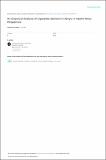An Empirical Analysis of Cigarettes Demand in Kenya: A Health Policy Perspective
Abstract/
This study focuses on empirical measurement of cigarettes demand in Kenya with an emphasis
on regulatory effects of cigarette prices and health warning labels on cigarette packs. A myopic
addiction model of cigarettes demand is used also to determine if past cigarette consumption per
capita has an effect on current cigarette consumption per capita. Other variables were income
and advertising. Ordinary Least Squares and Maximum likelihood- ARCH estimation methods
were used to estimate the long run cointegrating myopic cigarettes demand model. Furthermore,
short run myopic error correction cigarette demand model was also estimated. The estimated
long-run results indicated that cigarette prices have a significant and negative effect on cigarette
consumption per capita; this implies that the government can easily manipulate cigarette prices
by increasing excise tax. ML-ARCH estimation confirmed the existence of a positive and
significant myopic relationship between past and current cigarette consumption per capita. Real
income per capita proved to have results, which were contrary to the expectation that it will
increase consumption of cigarettes; nonetheless it was statistically significant and had negative
effect on cigarette consumption per capita in the long run. Health warning labels were found to
be effective in reducing cigarettes demand both in the short run and in the long run. Advertising
also was found to have a significant effect in promoting the use of tobacco in Kenya. Generally
increase in taxes, which is transmitted to the price factor, is the major advocated policy reaction
in controlling cigarettes (tobacco) use worldwide.
Collections
- Department of Economics [104]

